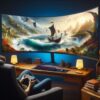Color Calibrations: Achieving Perfect Color Accuracy in Gaming Monitors
Color accuracy is essential for an optimal gaming experience, as it ensures that the colors displayed on the monitor accurately represent the intended visual content of games. However, achieving perfect color accuracy requires proper calibration and adjustment of gaming monitors. In this guide, we’ll explore the importance of color calibration in gaming monitors, the benefits of accurate color reproduction, and methods for achieving perfect color accuracy to enhance your gaming visuals.

Understanding Color Accuracy
The Importance of Color Accuracy:
Color accuracy refers to the fidelity of colors displayed on a monitor compared to their original, true colors. In gaming, accurate color reproduction is crucial for preserving the artistic integrity of game visuals, allowing players to experience games as intended by developers. Colors play a significant role in setting the mood, atmosphere, and immersion of games, making color accuracy essential for delivering immersive gaming experiences.
Benefits of Accurate Color Reproduction:
Accurate color reproduction offers several benefits for gamers, including enhanced visual clarity, improved image quality, and increased immersion. With precise color accuracy, gamers can experience vibrant and lifelike visuals, allowing them to fully immerse themselves in the game world and appreciate the fine details and artistic nuances of game graphics. Additionally, accurate color reproduction ensures consistency across different gaming environments, devices, and platforms, providing a uniform visual experience for gamers.
Methods for Color Calibration
Manual Calibration Techniques:
Manual calibration involves adjusting monitor settings, such as brightness, contrast, gamma, and color temperature, to achieve accurate color reproduction. Gamers can use built-in calibration tools or third-party software to fine-tune monitor settings based on visual references, color charts, or calibration targets. Manual calibration allows for precise adjustments tailored to individual preferences and gaming environments, ensuring optimal color accuracy for specific games and content.
Hardware Calibration Devices:
Hardware calibration devices, such as colorimeters and spectrophotometers, offer a more accurate and objective approach to monitor calibration. These devices measure and analyze the color output of the monitor and generate calibration profiles to correct color inaccuracies. Hardware calibration ensures consistent and reliable results across different monitors and environments, making it ideal for professional gamers, content creators, and enthusiasts who demand the highest level of color accuracy.
Optimizing Color Settings for Gaming
Game-specific Color Profiles:
Many games offer built-in color profile settings or presets that allow players to customize the visual appearance of the game to their preferences. Experiment with different color profiles, such as vivid, natural, or sRGB, to find the optimal balance between visual fidelity and performance. Additionally, adjust in-game graphics settings, such as brightness, contrast, and gamma, to further fine-tune color reproduction and enhance the gaming experience.
Advanced Color Management Tools:
Advanced color management tools, such as color grading software and monitor calibration software, provide additional options for optimizing color settings in gaming monitors. These tools allow users to create custom color profiles, adjust color gamut and saturation levels, and apply color grading effects to enhance visual quality and realism in games. Experiment with advanced color management tools to achieve personalized color settings that suit your gaming preferences and requirements.
Considerations for Gaming Monitors
Panel Technology and Color Accuracy:
The panel technology used in gaming monitors can influence color accuracy and reproduction capabilities. Different panel types, such as Twisted Nematic (TN), In-Plane Switching (IPS), and Vertical Alignment (VA), offer varying levels of color accuracy, viewing angles, and response times. IPS panels are known for their superior color reproduction and wide viewing angles, making them ideal for gaming monitors that prioritize color accuracy and visual quality.
HDR and Wide Color Gamut Support:
High Dynamic Range (HDR) and wide color gamut support enhance color accuracy and realism in gaming monitors by expanding the range of colors and luminance levels that can be displayed. HDR-compatible monitors offer greater contrast ratios, brighter highlights, and more vivid colors, resulting in lifelike visuals and improved immersion. Look for gaming monitors with HDR and wide color gamut support to experience games with richer, more vibrant colors and enhanced visual fidelity.


